5-hydroxytryptamine receptor 1B also known as the 5-HT1B receptor is a protein that in humans is encoded by the HTR1B gene. [5] [6] The 5-HT1B receptor is a 5-HT receptor subtype. [7]
5-hydroxytryptamine receptor 1B also known as the 5-HT1B receptor is a protein that in humans is encoded by the HTR1B gene. [5] [6] The 5-HT1B receptor is a 5-HT receptor subtype. [7]
5-HT1B receptors are widely distributed throughout the central nervous system with the highest concentrations found in the frontal cortex, basal ganglia, striatum, and the hippocampus. [8] The function of the 5-HT1B receptor differs depending upon its location. In the frontal cortex, it is believed to act as a terminal receptor inhibiting the release of dopamine. In the basal ganglia and the striatum, evidence suggests 5-HT signaling acts on an autoreceptor, inhibiting the release of serotonin [9] and decreasing glutamatergic transmission by reducing miniature excitatory postsynaptic potential (mEPSP) frequency, [10] respectively. In the hippocampus, a recent study has demonstrated that activation of postsynaptic 5-HT1B heteroreceptors produces a facilitation in excitatory synaptic transmission which is altered in depression. [11] When the expression of 5-HT1B in human cortex was traced throughout life, significant changes during adolescence were observed, in a way that is strongly correlated with the expression of 5-HT1E. [12]
Outside of the CNS, the 5-HT1B receptor is also expressed on the endothelium of blood vessels, particularly in the meninges. [13] Activation of these receptors results in vasoconstriction. The high distribution of vasoconstrictive 5-HT1B and 5-HT1D receptors around the brain makes them a valuable drug target for the treatment of migraines. [13]
Blocking 5-HT1B receptor signalling also increases the number of osteoblasts, bone mass, and the bone formation rate. [14]
Knockout mice lacking the 5-HT1B gene have been reported to have a higher preference for alcohol, although later studies failed to replicate such abnormalities in alcohol consumption. [15] These mice have also been reported to have a lower measure of anxiety (such as on the elevated plus maze test) and a higher measure of aggression. [15]
Under basal conditions, knockout mice present with a "normal" phenotype and exhibit a sucrose preference (lack of sucrose preference is considered a measure of anhedonia). However, after undergoing chronic unpredictable stress treatment to induce a "depression-like" phenotype these animals do not benefit from administration of selective serotonin reuptake inhibitor (SSRIs). [11] [ failed verification ]
In humans the protein is coded by the gene HTR1B.
A genetic variant in the promoter region, A-161T , has been examined with respect to personality traits and showed no major effect. [20]

5-HT receptors, 5-hydroxytryptamine receptors, or serotonin receptors, are a group of G protein-coupled receptor and ligand-gated ion channels found in the central and peripheral nervous systems. They mediate both excitatory and inhibitory neurotransmission. The serotonin receptors are activated by the neurotransmitter serotonin, which acts as their natural ligand.

Triptans are a family of tryptamine-based drugs used as abortive medication in the treatment of migraines and cluster headaches. This drug class was first commercially introduced in the 1990s. While effective at treating individual headaches, they do not provide preventive treatment and are not considered a cure. They are not effective for the treatment of tension–type headache, except in persons who also experience migraines. Triptans do not relieve other kinds of pain.

5-Hydroxytryptamine receptor 4 is a protein that in humans is encoded by the HTR4 gene.
The 5-HT1 receptors are a subfamily of the 5-HT serotonin receptors that bind to the endogenous neurotransmitter serotonin (also known as 5-hydroxytryptamine, or 5-HT). The 5-HT1 subfamily consists of five G protein-coupled receptors (GPCRs) that share 40% to 63% overall sequence homology, including 5-HT1A, 5-HT1B, 5-HT1D, 5-HT1E, and 5-HT1F. Receptors of the 5-HT1 type, specifically, the 5-HT1A and 5-HT1D receptor subtypes, are present on the cell bodies. Receptors of the 5-HT1 type, specifically, the 5-HT1B and 5-HT1D receptor subtypes, are also present on the nerve terminals. These receptors are broadly distributed throughout the brain and are recognized to play a significant part in regulating synaptic levels of 5-HT.

The serotonin 1A receptor is a subtype of serotonin receptors, or 5-HT receptors, that binds serotonin, also known as 5-HT, a neurotransmitter. 5-HT1A is expressed in the brain, spleen, and neonatal kidney. It is a G protein-coupled receptor (GPCR), coupled to the Gi protein, and its activation in the brain mediates hyperpolarization and reduction of firing rate of the postsynaptic neuron. In humans, the serotonin 1A receptor is encoded by the HTR1A gene.

5-hydroxytryptamine (serotonin) receptor 1D, also known as HTR1D, is a 5-HT receptor, but also denotes the human gene encoding it. 5-HT1D acts on the central nervous system, and affects locomotion and anxiety. It also induces vasoconstriction in the brain.

5-hydroxytryptamine (serotonin) 1E receptor (5-HT1E) is a highly expressed human G-protein coupled receptor that belongs to the 5-HT1 receptor family. The human gene is denoted as HTR1E.

5-hydroxytryptamine (serotonin) receptor 1F, also known as HTR1F is a 5-HT1 receptor protein and also denotes the human gene encoding it.
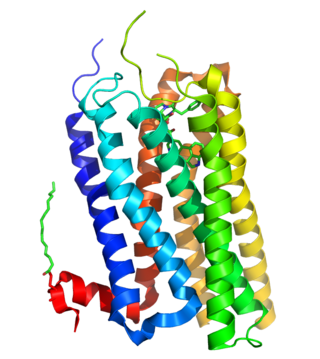
5-Hydroxytryptamine receptor 2B (5-HT2B) also known as serotonin receptor 2B is a protein that in humans is encoded by the HTR2B gene. 5-HT2B is a member of the 5-HT2 receptor family that binds the neurotransmitter serotonin (5-hydroxytryptamine, 5-HT). Like all 5-HT2 receptors, the 5-HT2A receptor is Gq/G11-protein coupled, leading to downstream activation of phospholipase C.

5-Hydroxytryptamine (serotonin) receptor 5A, also known as HTR5A, is a protein that in humans is encoded by the HTR5A gene. Agonists and antagonists for 5-HT receptors, as well as serotonin uptake inhibitors, present promnesic (memory-promoting) and/or anti-amnesic effects under different conditions, and 5-HT receptors are also associated with neural changes.

5-Carboxamidotryptamine (5-CT) is a tryptamine derivative closely related to the neurotransmitter serotonin.

CP-94253 is a drug which acts as a potent and selective serotonin 5-HT1B receptor agonist, with approximately 25x and 40x selectivity over the closely related 5-HT1D and 5-HT1A receptors. It has a range of behavioral effects, based on animal testing. The effects include the following: promoting wakefulness by increasing dopamine release in the brain; reducing food intake and promoting satiety; enhancing the reinforcing effects of cocaine; and possible antidepressant effects. A recent study found that "Regardless of sex, CP94253 decreased cocaine intake after abstinence and during resumption of SA [self-administration] and decreased cue reactivity" suggesting that agonism of the inhibitory 5-HT2B receptors may diminish the cognitive reward of cocaine usage and increased use of the drug without a period of abstinence may be a product of test subjects trying to achieve a previously rewarding experience through larger dosages of cocaine.
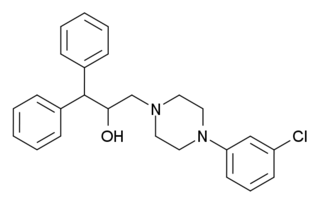
BRL-15,572 is a drug which acts as a selective antagonist for the serotonin receptor subtype 5-HT1D, with around 60x selectivity over other related receptors. The 5-HT1D receptor has a very similar pharmacology to the closely related 5-HT1B receptor, and most older ligands for these receptors bind to both subtypes with approximately equal affinity, so development of compounds such as BRL-15572 which are able to selectively block the 5-HT1D subtype while leaving 5-HT1B unaffected, have been a significant advance which has helped scientists in researching the function of these serotonin receptor subtypes. One function of the 5-HT1D receptor this research has revealed is its role in modulating release of the neurotransmitter glutamate in the brain, as well as functions in regulation of cerebral blood pressure which are important in the pathogenesis of migraine headaches.

SB-216641 is a drug which is a selective antagonist for the serotonin receptor 5-HT1B, with around 25x selectivity over the closely related 5-HT1D receptor. It is used in scientific research, and has demonstrated anxiolytic effects in animal studies.

GR-127935 is a drug which acts as a selective antagonist at the serotonin receptors 5-HT1B and 5-HT1D. It has little effect when given by itself but blocks the antiaggressive effect of 5-HT1B agonists, and alters release of serotonin in the brain, as well as reducing drug-seeking behaviour in cocaine addicted rats.
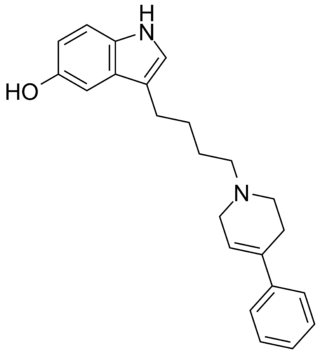
Roxindole (EMD-49,980) is a dopaminergic and serotonergic drug which was originally developed by Merck KGaA for the treatment of schizophrenia. In clinical trials its antipsychotic efficacy was only modest but it was unexpectedly found to produce potent and rapid antidepressant and anxiolytic effects. As a result, roxindole was further researched for the treatment of depression instead. It has also been investigated as a therapy for Parkinson's disease and prolactinoma.
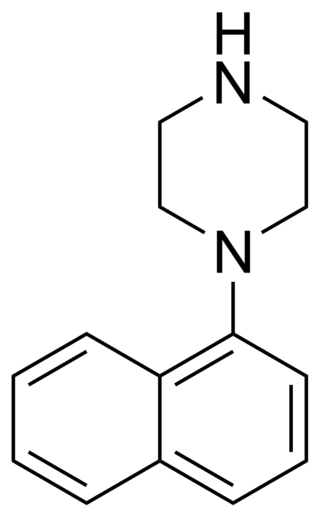
1-(1-Naphthyl)piperazine (1-NP) is a drug which is a phenylpiperazine derivative. It acts as a non-selective, mixed serotonergic agent, exerting partial agonism at the 5-HT1A, 5-HT1B, 5-HT1D, 5-HT1E, and 5-HT1F receptors, while antagonizing the 5-HT2A, 5-HT2B, and 5-HT2C receptors. It has also been shown to possess high affinity for the 5-HT3, 5-HT5A, 5-HT6, and 5-HT7 receptors, and may bind to 5-HT4 and the SERT as well. In animals it produces effects including hyperphagia, hyperactivity, and anxiolysis, of which are all likely mediated predominantly or fully by blockade of the 5-HT2C receptor.
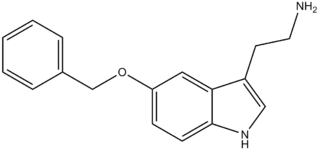
5-Benzyloxytryptamine (5-BT), is a tryptamine derivative which acts as an agonist at the 5-HT1D, 5-HT2 and 5-HT6 serotonin receptors, and an antagonist of TRPM8.

Donitriptan (INN) is a triptan drug which was investigated as an antimigraine agent but ultimately was never marketed. It acts as a high-affinity, high-efficacy/near-full agonist of the 5-HT1B and 5-HT1D receptors, and is among the most potent of the triptan series of drugs. Donitriptan was being developed in France by bioMérieux-Pierre Fabre and made it to phase II clinical trials in Europe before development was discontinued.

LY-393558 is a potent serotonin reuptake inhibitor and antagonist of the 5-HT1B, 5-HT1D, and 5-HT2A receptors. LY-393558 was also found to reduce serotonin-induced vasoconstriction, indicating that it may have therapeutic potential for the treatment of pulmonary hypertension.
This article incorporates text from the United States National Library of Medicine, which is in the public domain.